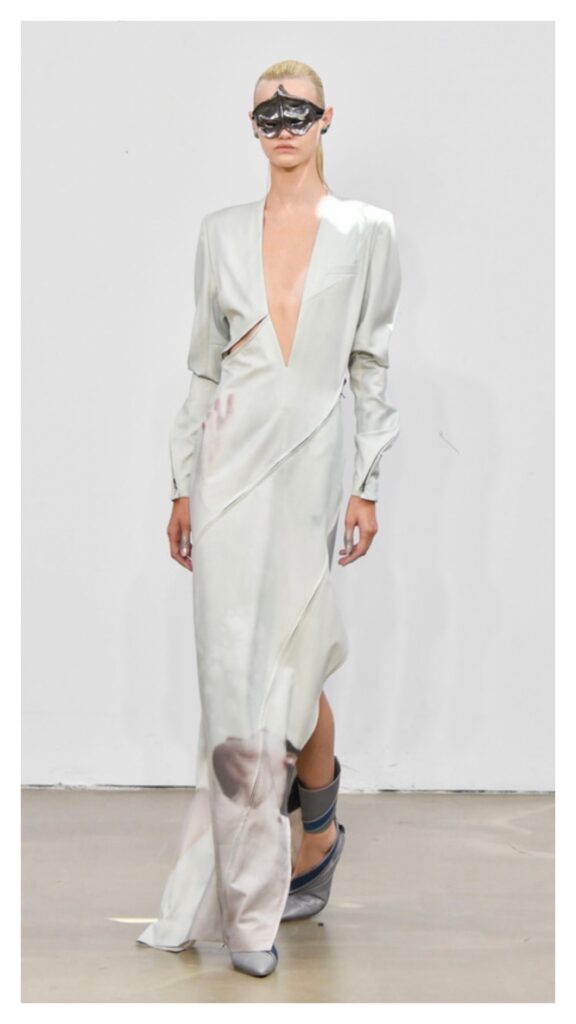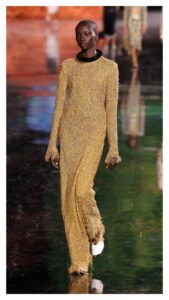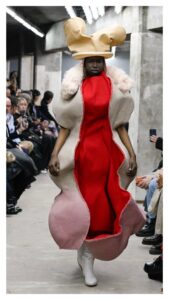Primal Protection: Exploring the Essence of Clothing
At the core of Nakazato’s collection is the exploration of clothing as a fundamental form of protection against the elements. Drawing from his experiences in the raw and elemental environment of Northern Finland, the designer sought to capture the essence of how clothing serves as a barrier between the body and the harshness of nature.
The collection’s title, “Glacier,” serves as both a metaphor and a literal representation of the icy landscapes that inspired it. Nakazato’s garments evoke the stark beauty of glaciers, utilizing materials and designs that reflect the delicate yet formidable nature of these frozen structures. The designer’s artistic vision encourages a reconsideration of clothing, pushing the boundaries of traditional fashion to encompass deeper meanings related to survival and existence.
Fragility and Resilience: Materials that Speak
In a captivating juxtaposition, Nakazato delves into the themes of fragility and resilience throughout the collection. By employing materials that embody both delicacy and strength, he invites viewers to contemplate the vulnerability of the human body—both physically and emotionally.
Key elements of the collection include meticulously crafted garments and masks made from thousands of ceramic pieces. These intricate designs are intended to fracture, exposing the vulnerability that lies beneath a hardened exterior. The use of ceramics, often associated with fragility, challenges perceptions of strength and beauty in fashion. Nakazato’s artistic approach compels us to acknowledge that true resilience often exists in the face of vulnerability.
Concealment and Identity: Questioning Contemporary Issues
The collection’s use of ceramic masks and “fragile armor” speaks to contemporary issues surrounding identity and vulnerability in a technologically saturated world. In an era where digital personas often overshadow authentic selves, Nakazato’s designs provoke thought about the masks we wear—both literally and metaphorically.
The ceramic masks, which cover the face, serve as a powerful statement on concealment and the complexities of identity. They evoke a sense of alienation while also inviting introspection. By incorporating these elements into his collection, Nakazato challenges the audience to consider how societal pressures influence our self-perception and the ways we present ourselves to the world.
A Fusion of Innovation and Beauty: Key Elements of the Collection
The “Glacier” collection features an array of striking materials and designs that encapsulate Nakazato’s vision. Among the standout elements are:
– Ceramic Garments and Masks: These meticulously crafted pieces, composed of numerous ceramic shards, embody fragility while drawing attention to the vulnerability that lies within. The intentional cracking of the ceramics serves as a metaphor for exposing one’s true self and the strength found in that exposure.
– Holographic Fabrics: Inspired by the glistening surfaces of icy landscapes, Nakazato employs semi-transparent holographic fabrics layered and supported by wire. This innovative approach creates a gill-like appearance, evoking the sense of movement and fluidity inherent in nature.
– Hand-Knitted Pieces: The collection also features tactile hand-knitted garments that intertwine wool and metal chains. This combination represents the contrasting forces of warmth and cold, strength and fragility, highlighting the complexities of human experience.
– Photographic Prints: Giant prints of nude photographs, captured by Nakazato himself in the frigid environment of Finnish Lapland, are integrated into the collection. These images not only serve as striking visual elements but also further emphasize the themes of vulnerability and exposure.
– Sculptural Forms: The designs incorporate sculptural elements, including shell-like structures and alienating face masks, which contribute to the haunting beauty of the collection. These forms challenge conventional silhouettes in fashion, encouraging a redefinition of beauty that transcends traditional norms.
Runway Presentation: A Hauntingly Beautiful Experience
The runway presentation of Nakazato’s “Glacier” collection was a testament to the designer’s artistic vision. With the stark backdrop of the Palais de Tokyo accentuating the collection’s themes, viewers were transported into a world where nature’s power and human vulnerability coalesce.
As models glided down the runway, their movements echoed the fluidity of the icy landscapes that inspired the collection. The interplay between light and shadow enhanced the garments’ ethereal qualities, creating a mesmerizing visual experience. Each piece resonated with the audience, inviting them to reflect on their own perceptions of protection, identity, and fragility.
The collection’s impact extended beyond the runway, sparking conversations about the role of fashion in addressing profound societal issues. Nakazato’s ability to intertwine art and fashion into a cohesive narrative is a testament to his innovative approach and artistic sensibilities.
Conclusion: A Reflection on Human Experience
Yuima Nakazato’s Fall/Winter 2025 Haute Couture collection, “Glacier,” represents a compelling exploration of the complexities of human experience. By drawing inspiration from the elemental beauty of Finnish Lapland, the designer has created a collection that transcends traditional fashion, inviting viewers to engage in a dialogue about vulnerability, resilience, and the essence of protection.
As the fashion world continues to evolve, Nakazato’s work serves as a reminder that clothing is not merely a form of adornment; it is a reflection of our innermost selves and a means of navigating the complexities of contemporary life. In a world where identity is often masked by superficiality, Nakazato’s collection encourages authenticity, urging us to embrace both our fragilities and strengths.
With “Glacier,” Yuima Nakazato has not only presented a stunning collection but has also challenged the fashion industry to confront deeper themes that resonate with the human experience. As the applause echoed in the Palais de Tokyo, it was clear that Nakazato’s artistic vision had left an indelible mark on Haute Couture Week, and perhaps on the future of fashion itself.











